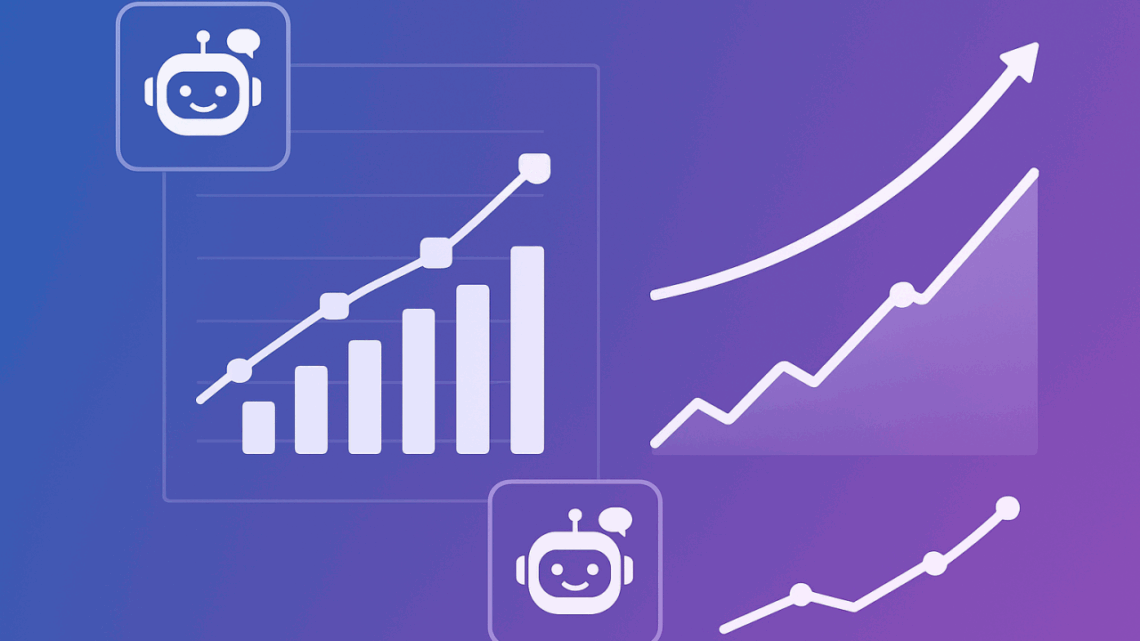Chatbots are now an integral part of the web. Of all AI tool traffic, they now claim over half of the market share.
Between August 2024 and July 2025, chatbots managed to rake in 55.88 billion visits. This accounted for 58.8% of all AI tool traffic. This was discovered by a major online SEO agency, which conducted a survey that looked at 10,500 AI-related tools. It monitored key metrics such as web visits, media articles, monthly traffic growth, and bounce rates.
ChatGPT Retains the Market Share
ChatGPT remained at the top of the pile. It drew 46.6 billion visits, a rise of 105% in a year. This gave it a market share of 48.36% of the whole AI market. Even more interesting was traffic to DeepSeek. The Chinese tech company saw its visits balloon to 2.7 billion per year, a dramatic increase of over 48,848% year upon year. However, this declined as quickly as it had arrived, with a traffic drop of 39.5% in the six months leading up to July.
This rise in AI-based chatbot traffic has led to a surge in what is being termed ‘GEO’. As opposed to Search Engine Optimization, which comes from standard traffic searches, GEO measures traffic from AI sources like chatbots. This has made an AI chatbot traffic tracker a new and popular tool in staying ahead of the search curve. They allow key metrics to be tracked from AI bots, allowing marketers and webmasters to see the prompts, landing pages, and shifts that bring traffic to a website.
The best of the rest included Google’s Gemini. This managed to record a 156% rise in the same period. It now stands at around 246.2 million visits per month. Lower than this, and both having less than 150 million visits each month were Mistral and Meta AI.
AI Traffic Turning the Web Upside Down
If the need for AI-based traffic checkers requires more reiterating, then a recent survey by Fastly shows just how quickly web traffic is changing. It now suggests that AI crawlers are making up around 80% of AI bot traffic. Oddly, most of this is coming from social media company Meta, who eclipse both Google and OpenAI, owners of ChatGPT.
The survey classified AI bots into two categories. These were crawlers. They generally operate independently, scanning websites for information on which they can build indexes or train language models. They make up around 80% of AI bot traffic. Industries that have faced a high level of crawler traffic have tended to include tech, media and entertainment, and ecommerce.
Fetchers work differently, and they access in response to user actions. For example, they may scan a website for information regarding products that relate to a search. They make up around 20% of traffic. Of these, around 98% of traffic is attributable to OpenAI’s ChatGPT. It has also been noticed that they have been extremely aggressive. One bot was noted to have made 39,000 requests to a website in a minute.
For those running a website, this can cause serious issues. Distinguishing the two traffic types is imperative. Essentially, only 20% is valuable to a business owner, as, despite being AI, behind it is a human search that could lead to conversions.
Adapting to AI-Powered Search
Adapting to AI-powered search requires not just technical shifts, but also a willingness to adapt goals and orient to different methods. One of these fundamental changes is to look past simple web traffic and make engagement a priority. This is because, despite a general drop in traffic, AI-generated traffic is generally of a better quality. Visitors are arriving with context that has been backed by a service they trust. This may see people spend more time, and by optimising landing pages and personalizing their journey, you can ensure this results in higher conversions.
When it comes to content, particularly written content, expertise is key. With short-form content, this is often hard to demonstrate. Thus, you should position your site as an expert by creating long-form content, rich in long-tail keywords and phrases. These should also be optimised for searches made other than through an engine, using natural models like voice-driven search.
When it comes to building authority off-page, then content elsewhere is key. Make sure you begin to engage in everything from videos to podcasts that link back and position you in authority. Social media is a key part of this, so try to appear in other people’s feeds and content as much as possible.
AI is still in its infancy, and so are the means to harness traffic from it. Therefore, this will be a calculated approach and one that must be refined. There is no concrete strategy to work from. However, businesses willing to adapt and think ahead will undoubtedly reap the rewards, managing to pull traffic and leads away from their competition.





